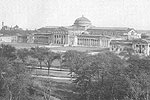|

South Lakefront
(continued)
During the next decade Hyde Park experienced tremendous growth.
The town was suddenly caught up in the quick expansion of Chicago,
overwhelming Cornell's dream of an elite suburb. Row houses and
working-class cottages appeared on side streets adjacent to mansions.
City services became inadequate. The new mass transit system encouraged
the development of commercial shopping strips, which sprang up
near the IC stops and along 53rd and 55th Streets. The 1880s saw
Hyde Park change from a quiet village to an urban neighborhood.
Faced with this changed environment, township residents proposed
annexation to the City of Chicago. In 1887 a referendum was defeated,
but two years later it passed, and the entire township disappeared
from the map, becoming part of the city. In both instances, however,
those who lived in the original core settlement voted against
annexation. They were overruled after a bitter struggle, and Hyde
Park became a part of Chicago in 1889.
Two events soon occurred which pushed Hyde Park into the modern
era. In 1890 Chicago won the fight to host the World's Columbian
Exposition in the parks which surrounded Hyde Park. This victory
resulted in a surge of new construction (See Fig.
1). Hotels, stores, and apartment buildings sprang up everywhere,
but especially near the site of the fair. In the midst of this
development, Hyde Park almost lost its identity. It was on the
verge of becoming just another South Side neighborhood swallowed
up by the city's tremendous growth following the Civil War. It
seemed that the golden age of the settlement was gone forever.
«
previous
8
of 23
next
»
|
 |

|
|


Figure 1:
Old Field Museum building, 57th at Lake Shore Drive, 1924.
»
|